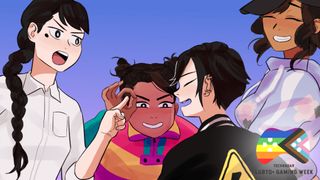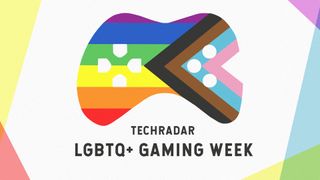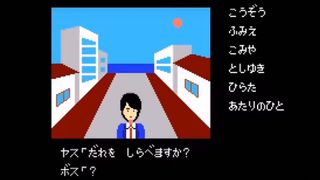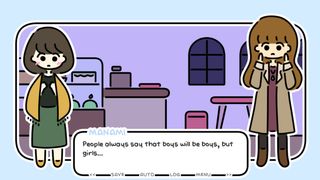The history of LGBTQ+ visual novels
The medium that dominates queer indie games


Welcome to TechRadar's LGBTQ+ Gaming Week 2021. During this week-long celebration, we're highlighting topics and voices within the LGBTQ+ gaming community. Find out more here.
Despite an increase in the number of LGBTQ+ characters in AAA video games, including Ellie in The Last of Us and Chloe in Life is Strange, there are still not many. LGBTQ+ people have often looked to indie games to see queer stories – and when it comes to the queer indie scene there’s one genre that's king.
If you’re scrolling through the LGBTQ tags on itch.io or Steam you’ll find that a big chunk of the indie LGBTQ+ games that are available are visual novels. This includes popular queer games like Butterfly Soup, Dream Daddy, Heaven Will Be Mine, and Ladykiller in a Bind. But why are there so many queer visual novels? What attracts both LGBTQ+ developers and players to the medium? In an attempt to answer that question we took a look at the history of the queer visual novel.
The makings of the first visual novels

The game that could be considered the first iteration of the LGBTQ+ visual novel, and the first LGBTQ+ game, is Caper in the Castro, a point-and-click detective game released in 1989 by CM Ralph. You play as lesbian detective Tracker McDyke, who’s searching for a woman named Tessy LaFemme, who’s gone missing. The game was a tribute to the San Francisco LGBTQ+ community, and included a lot of tongue-in-cheek queer references and puns, including a villain named Dullagan Straightman.
Caper was also distributed as ‘charityware’, with each person who downloaded the game asked to donate to an AIDS relief organization. The game was met with positivity from the underground LGBTQ forums it was originally distributed through, particularly since it was the first time someone made a game with LGBTQ+ characters or themes.
In an interview with Paste Magazine in 2014, CM Ralph talked about how they also made a heterosexual version of Caper called Murder on Mainstreet, which was published by Heizer Software.
“Basically all I did was change the names and places,” Ralph told Paste. “My reasoning was that I wanted to tap into the mainstream audience – 1988 was a lot different than 2014 when it came to how LGBT people and issues were viewed and treated.”
"It’s possible that LGBTQ+ developers leaned into the visual novel and dating sim because they offered a template for how to portray romantic narratives, regardless of whether they’re heterosexual or not."
While the game itself was groundbreaking in its content, at the time it was clear that there wasn’t yet a place for queer games in the mainstream.
Get daily insight, inspiration and deals in your inbox
Sign up for breaking news, reviews, opinion, top tech deals, and more.
While Caper in the Castro wasn’t a visual novel, point-and-click adventure games are considered the precursor to visual novels. While point-and-click games are focused more on puzzles, visual novels adopted their style, but with a greater focus on narrative.
The Portopia Serial Murder Case, which is widely considered the first visual novel, was cited to have been directly inspired by American point-and-click adventure games like King’s Quest. The creator of Portopia, Yuji Horii, said the game was made in an attempt to introduce Japanese audiences to American adventure games.
Dating sims came a bit later, and can be considered a type of visual novel that focuses on romancing characters. While the origin of the dating sim can’t be as easily traced as that of the visual novel, the first game to popularize the mechanics and aesthetics seen in both mediums is Tokimeki Memorial.
This game introduced concepts like managing romantic relationships through daily activities, and choosing from a set of options that affect the story, and which romantic partner you end up with. It also popularized the use of interchangeable sprites and backgrounds, which can be seen in many visual novels today. Visual novels are foundational to romance in games, though it’s rarely acknowledged.
It’s possible that LGBTQ+ developers leaned into the visual novel and dating sim because they offered a template for how to portray romantic narratives, regardless of whether they’re heterosexual or not.
The queer visual novel boom in the 2010s

It should be noted that, according to the Visual Novel Database, there were Asian visual novels that featured same-sex romantic relationships that were released as early as the 1990s, but these are somewhat harder to track down because many weren’t translated to English. According to the LGBTQ Video Game Archive, queer visual novels didn’t break through in the West until the 2010s. It seems that they took a surprisingly long time to reach English-speaking audiences, and queer developers made sure they did by making their own.
Notable queer visual novels from the early 2010s include Ladykiller in a Bind creator Christine Love’s first visual novels, Don't Take It Personally, Babe, It Just Ain't Your Story; and Analogue: A Hate Story. The former is a story about queer teens and the internet, and the latter a transhumanistic visual novel about reading the crew logs of a ship that disappeared mysteriously. Love’s popular erotic rom-com game, Ladykiller in a Bind, would come out later in 2016, followed by Butterfly Soup, a groundbreaking queer love story about Asian-American teens, and Dream Daddy, one of the most popular gay dating sims, which came out in 2017.
In 2015 the first Yuri Jam, a two-month-long game jam focused on making video games (particularly dating sims and visual novels) with sapphic relationships in them, was hosted on itch.io, and resulted in the creation of over 30 sapphic games. It was followed in 2016 by the first Yaoi Jam for male relationships in video games. These game jams are annual, and the last Yuri Jam attracted over 40 entries. The creation of queer-themed game jams on itch.io has definitely encouraged the creation of queer visual novels, and explains why itch.io’s library is brimming with them.
Itch.io has one of the most robust collections of LGBTQ+ indie games, from a fan-made Life is Strange dating sim to a gay mecha brawler to a short text-based game about watching a gay cowboy movie. It’s clear that queer game developers have found places to thrive that weren’t there when CM Ralph had to ‘straighten’ Caper in the Castro for the mainstream.
Why do LGBTQ+ developers gravitate to visual novels?

One reason why LGBTQ+ developers gravitate towards visual novels is that the genre is a relatively friendly medium to work with.
"Visual novels are really great mediums for a lot of people, but I think part of their appeal is how easy they are to make in terms of the skill set required and actual financial cost."
Minute - Studio Élan
“Visual novels are really great mediums for a lot of people, but I think part of their appeal is how easy they are to make in terms of the skill set required and actual financial cost,” says Minute, the head programmer at Studio Élan, which made Highway Blossoms and Heart of the Woods.
“To make a visual novel, all you really need is a story and a basic grasp of whatever system you're using. The Ren'Py visual novel engine has a really low barrier of entry, but it's powerful enough that you can create some amazing things with it too. Everything else, like custom art, music, UI, and so on, is just icing on the cake, because the availability of free assets on the web right now is incredible.”
Minute also explains that people of marginalized identities may not have the resources, time, or connections to make a large game, but they do have stories to tell, and “Visual novels are a medium that celebrates that.”
When there was no representation for LGBTQ+ people in video games, LGBTQ+ people took it upon themselves to make it with whatever resources they had. Going back all the way to Caper in the Castro there’s been a continuum of queer people making queer games, and while some players may disregard visual novels they played a significant role, and one that should be celebrated.
Mainstream video games still need to catch up when it comes to the diversity that can be found in visual novels. Even though queer representation can these days show up in action-adventure games and first-person shooters, the humble visual novel has its place within queer game history – and as long as LGBTQ+ developers feel the need to tell their own stories it always will.
Harriette Chan is a cheesecake enthusiast, video game lover, and disgruntled college student. When they grow up they want to be a writer, or an archaeologist, or a barista. Whatever, they'll figure it out. They are currently working towards their BFA in Creative Writing.
Harriette is a cheesecake enthusiast, video game lover, and disgruntled college student. When they grow up they want to be a writer, or an archaeologist, or a barista. Whatever, they'll figure it out. They are currently working towards their BFA in Creative Writing.
